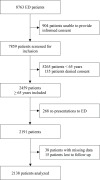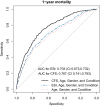The clinical frailty scale predicts 1-year mortality in emergency department patients aged 65 years and older
- PMID: 35138670
- PMCID: PMC9320818
- DOI: 10.1111/acem.14460
The clinical frailty scale predicts 1-year mortality in emergency department patients aged 65 years and older
Abstract
Objective: To validate the Clinical Frailty Scale (CFS) for prediction of 1-year all-cause mortality in the emergency department (ED) and compare its performance to the Emergency Severity Index (ESI).
Methods: Prospective cohort study at the ED of a tertiary care center in Northwestern Switzerland. All patients aged ≥65 years were included from March 18 to May 20, 2019, after informed consent. Frailty status was assessed using CFS, excluding level 9 (palliative). Acuity level was assessed using ESI. Both CFS and ESI were adjusted for age, sex and presenting condition in multivariable logistic regression. Prognostic performance was assessed for discrimination and calibration separately. Estimates were internally validated by Bootstrapping. Restricted mean survival time (RMST) was determined for all levels of CFS.
Results: In the final study population of 2191 patients, 1-year all-cause mortality was 17% (n = 372). RMST values ranged from 219 days for CFS 8 to 365 days for CFS 1. The adjusted CFS model had an area under receiver operating characteristic of 0.767 (95% confidence interval [CI]: 0.741-0.793), compared to 0.703 (95% CI: 0.673-0.732) for the adjusted ESI model.
Conclusion: The CFS predicts 1-year all-cause mortality for older ED patients and predicts survival time in a graded manner. The CFS is superior to the ESI when adjusted for age, sex, and presenting condition.
Trial registration: ClinicalTrials.gov NCT03892551.
© 2022 The Authors. Academic Emergency Medicine published by Wiley Periodicals LLC on behalf of Society for Academic Emergency Medicine.
Conflict of interest statement
M.R. reports no conflict of interest. S.K.N. reports no conflict of interest. M.B. reports no conflict of interest. T.K. reports no conflict of interest. T.D. reports no conflict of interest. C.R.C. is contracted collaborator with the Geriatric ED Collaborative, Geriatric Emergency Care Applied Research (GEAR) Network, and ACEP Geriatric ED Accreditation Board of Governors. RB reports no conflicts of interest. CHN reports no conflicts of interest.
Figures



Comment in
-
Do we really need another risk prediction rule? Yes, we do.Acad Emerg Med. 2022 May;29(5):678-680. doi: 10.1111/acem.14458. Epub 2022 Mar 22. Acad Emerg Med. 2022. PMID: 35139248 Free PMC article. No abstract available.
References
-
- Grossmann FF, Nickel CH, Christ M, Schneider K, Spirig R, Bingisser R. Transporting clinical tools to new settings: cultural adaptation and validation of the Emergency Severity Index in German. Ann Emerg Med. 2011;57:257‐264. - PubMed
-
- Nickel CH, Kellett J, Nieves Ortega R, et al. A simple prognostic score predicts one‐year mortality of alert and calm emergency department patients: a prospective two‐center observational study. Int J Clin Pract. 2020;74:e13481. - PubMed
Publication types
MeSH terms
Associated data
LinkOut - more resources
Full Text Sources
Medical

